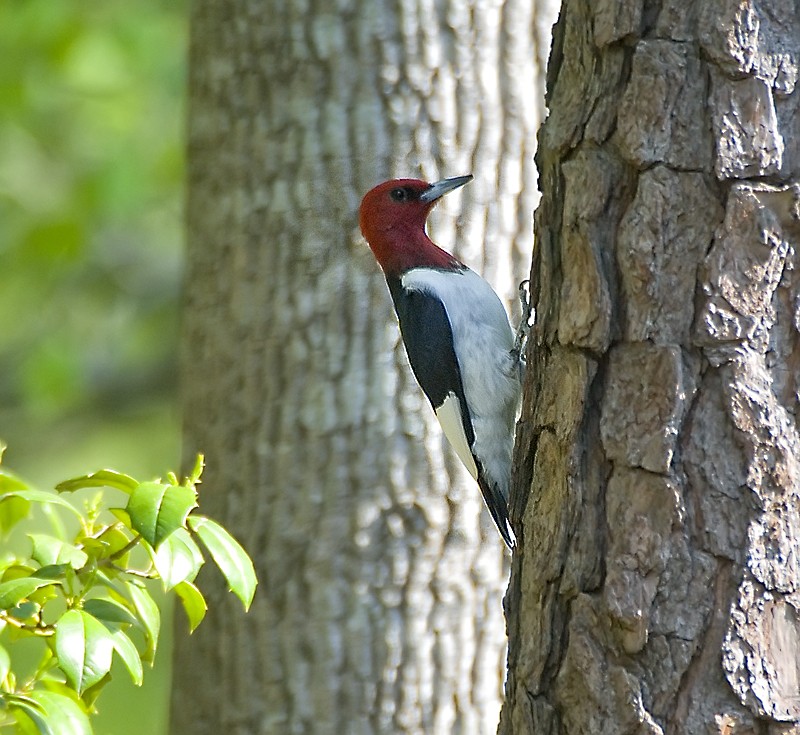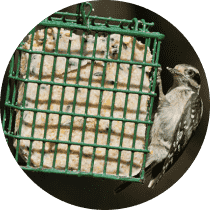Red-headed Woodpecker
A species of Melanerpine Woodpeckers, Also known as Shirt-tail Bird, Jellycoat Scientific name : Melanerpes erythrocephalus Genus : Melanerpine Woodpeckers
Red-headed Woodpecker, A species of Melanerpine Woodpeckers
Also known as:
Shirt-tail Bird, Jellycoat
Botanical name: Melanerpes erythrocephalus
Genus: Melanerpine Woodpeckers
Content
Description People often ask General Info
 Photo By colleen , used under CC-BY-SA-2.0 /Cropped and compressed from original
Photo By colleen , used under CC-BY-SA-2.0 /Cropped and compressed from original Description
An instantly recognizable bird, the red-headed Woodpecker is a medium-sized woodpecker that prefers an open country full of dead trees. This striking bird is quite skilled at catching insects in the air. One of the four woodpeckers that store food for winter, this clever bird even covers the food with a piece of bark. A true North American woodpecker, it is a war symbol of the Cherokees.
Size
22-23 cm (8.5-9.25 in)
Life Expectancy
9 years
Nest Placement
Cavity
Clutch Size
3 - 10 eggs
Incubation Period
1 - 2 broods
Number of Broods
12 - 14 days
Nestling Period
24 - 31 days
Feeding Habits
Red-headed Woodpecker consume approximately one-third animal matter, especially beetles and cicadas, and two-thirds plant matter, including seeds, nuts, and fruits. Skilled flycatchers, they catch insects mid-air from perches. They cache surplus food, shifting storage before retrieval, and forage from the ground to treetops, seasonally adjusting their diet.
Habitat
Red-headed Woodpecker thrives in open deciduous woodlands, particularly with oak and beech, and areas with dead or dying trees for nesting. Their adaptable nature also brings them to river bottoms, burned forests, beaver swamps, and forest edges. Additionally, they inhabit human-modified landscapes like orchards, parks, and urban areas with mature shade trees.
Nest Behavior
Both sexes excavate the nest, predominantly the male, usually completing it in 12-17 days. Nesting includes reusing cavities for multiple years, with coordinated efforts for nest approval and construction.
Nest Characteristics
Red-headed Woodpecker typically selects dead trees or limbs and utility poles for nest sites, often where the bark is gone. They may utilize natural cavities or reuse old ones. The nest cavity is gourd-shaped, about 3-6 inches wide and 8-16 inches deep with a 2-inch entrance.
Dite type
Omnivorous
People often ask
General Info
Feeding Habits
Bird food type
Bird Feeder Type

Suet Cage
Sounds
Call
Recording location: United States
Call
Recording location: United States
Behavior
Red-headed Woodpecker exhibit unique behaviors among woodpeckers, such as capturing insects in flight and engaging in 'hide and seek' courtship. These strong and stable fliers maintain a territorial nature, often defending their area fiercely against other birds. The distinctive bobbing displays in both sexes during aggression, marked by pointed heads, drooping wings, and raised tails, are a notable aspect of their behavior. Aside from their solitary winter existence, red-headed Woodpecker may form lasting pair bonds over several breeding seasons and show resilience against various predators, from snakes to larger raptors.
Species Status
The red-headed woodpecker is rated as least concern on the International Union for Conservation of Nature (IUCN)'s Red List of Endangered species. It was formerly rated as near threatened, having been reclassified from Least Concern in 2004 after it appeared to have experienced a 65.5% decline in population over 40 years; from 1966-2015 there was a greater than 1.5% annual population decline throughout the Mississippi and Ohio River valleys, and in central Florida. Increased habitat management, however, has caused its numbers to stabilize, thus leading to its downlisting. The red-headed woodpecker was historically a common species in southern Canada and the east-central United States. Consistent long-term population declines have resulted in red-headed woodpecker's threatened status in Canada and several states in the US. Throughout most of its range it inhabits areas that have been heavily altered by humans. Factors suggested for red-headed woodpecker declines include: loss of overall habitat and, within habitats, standing dead wood required for nest sites, limitations of food supply, and possible nest-site competition with other cavity nesters such as European starlings or red-bellied woodpeckers. Of the 600 Canadian Important Bird Areas only seven report the red-headed woodpecker in their area: Cabot Head, Ontario on the Georgian Bay side of the tip of Bruce Peninsula; Carden Plain, Ontario east of Lake Simcoe; Long Point Peninsula and Marshes, Ontario along Lake Erie near London, Ontario; Point Abino, Ontario on Lake Erie near Niagara Falls; Port Franks Forested Dunes, Ontario northeast of Sarnia on Lake Huron; Kinosota/Leifur, Manitoba at the northwest side of Lake Manitoba south of The Narrows and east of Riding Mountain National Park; and along South Saskatchewan River from Empress, Alberta to Lancer Ferry in Saskatchewan. 
Scientific Classification
Phylum
Chordates Class
Birds Family
Woodpeckers Genus
Melanerpine Woodpeckers Species
Red-headed Woodpecker